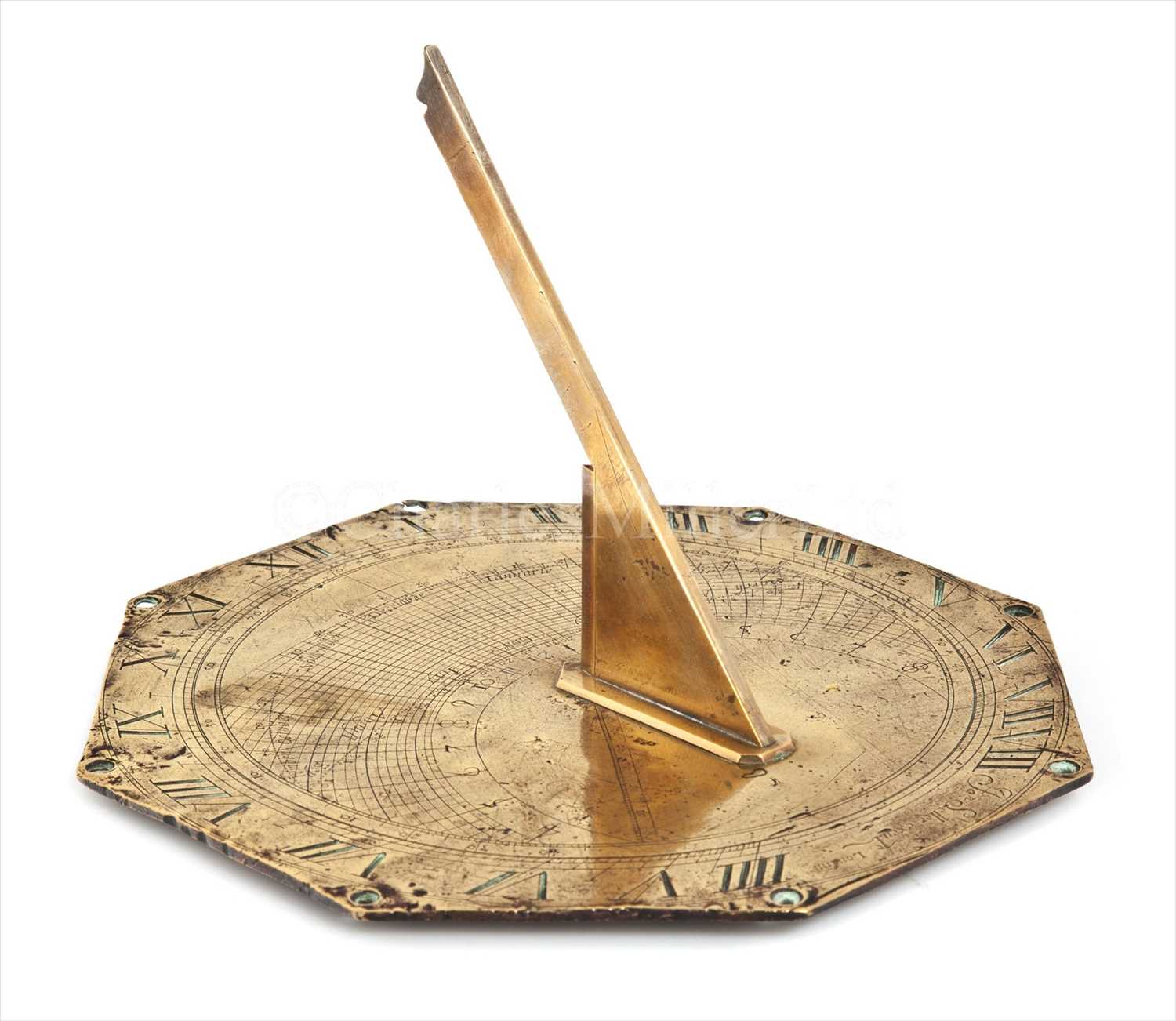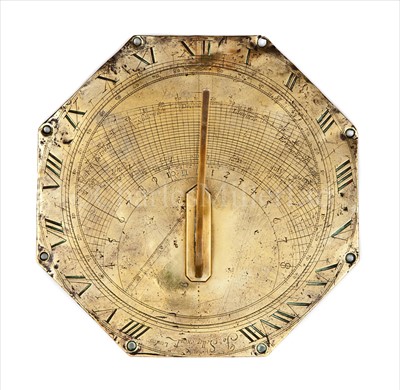26th Oct, 2011 12:00
Maritime and Scientific Models, Instruments & Art (Implacable)
169
[M] AN HISTORICALLY INTERESTING 17TH-CENTURY...
over-signed in the chapter ring Jon. Seller excut Londini, octagonal form, the corners pierced for screws, engraved plate for solar declination and hours, gnomon (later) underpinned at centre -- 8in. (20cm.) diameter
Invented by his friend William Oughtred, Allen produced several of these dials and this one conforms closely to one held in the National Collection at Greenwich (AST0232). Known as "double horizontal" dials because they have two scales for reading the hours using the angled side of the gnomon, and the vertical supporting edge, this second edge shows the lines of solar declination, the ecliptic and the right ascension of the sun. They were useful not only for telling the time but for demonstrating the motion of the sun throughout the day and year, being able to also calculate the altitude of the Sun and its azimuth as well as showing the position of the Sun on the ecliptic. As an instrument, they enjoyed a flourish around the mid-late 17th Century, but not many appear to have been made post-1700. Interestingly Samuel Pepys wrote in his diary for 3rd June, 1663: Up betimes, and studying my double diall... Dean Honiwood comes to me, who dotes mightily upon it and I think I must give it him. and on the 4th June: Home by water, where by and by comes Dean Honiwood, and I showed him my double horizontal diall, and promise to give him one, and that shall be it.
Elias Allen (c.1588-1653) Apprenticed to Charles Whitwell of the Grocers' Company, he was renowned in his day and had a close relationship with contemporary mathematicians. He joined the Clockmakers' Company in 1633 and became their Master 1637-8. He produced a wide range of precision measuring instruments.
John Seller (1632-1697) was a leading mathematical practitioner and map maker of his day, and also something of a colourful character - or rogue - who enjoyed the Royal patronage one year, and was jailed in Newgate the next! It seems that he may have acquired the remaining stock of Allen's workshop on his death in 1653 and passed a few instruments off as his own work - certainly this is the only known dial that bears his signature and, when examined closely and compared to other Allen dials, has even incorporated elements of Allen's signature. For a detailed biography of Seller, the May/June and July/August 2009 editions of Navigation News carry a two-part article on this fascinating character.
Literature: Higton, H: Sundials at Greenwich, OUP/NMM, 2002, p.58-9
Davis & Daniel: John Seller: Instrument Maker and Plagiarist, SIS
Bulletin No.102, September 2009, p.6-10.
Dawes, H: Instruments of the Imagination, Dawes Trust, 2009, p.23-4.
Davis, J & Lowne, M: The Double Horizontal Dial, BSS Monograph No 5,
London, 2009.
Sold for £9,300
Estimated at £2,000 - £3,000
(inc. buyer's premium of 24%)
Condition Report
The dial has the usual pitting and wear associated with an instrument of this age, but is essentially in strong overall condition, with good clear deliniation still present. The Gnomon conforms closely to the Allen dial at Greenwich, but is thought to be a 19th Century replacement, but an accurate one designed for use, and not a decorative substitute.
We are pleased to provide you with a general report of the condition of this property. Since we are not professional conservators or restorers, we urge you to consult with a restorer or conservator of your choice who will be better able to provide a detailed, professional report. Prospective buyers should inspect each lot to satisfy themselves as to condition and must understand that any statement made by Charles Miller Ltd is merely a subjective, qualified opinion. Prospective buyers should also refer to any Important Notices regarding this sale, which are printed in the Sale Catalogue. NOTWITHSTANDING THIS REPORT OR ANY DISCUSSIONS CONCERNING A LOT, ALL LOTS ARE OFFERED AND SOLD “AS IS” IN ACCORDANCE WITH THE CONDITIONS OF BUSINESS PRINTED IN THE SALE CATALOGUE.
over-signed in the chapter ring Jon. Seller excut Londini, octagonal form, the corners pierced for screws, engraved plate for solar declination and hours, gnomon (later) underpinned at centre -- 8in. (20cm.) diameter
Invented by his friend William Oughtred, Allen produced several of these dials and this one conforms closely to one held in the National Collection at Greenwich (AST0232). Known as "double horizontal" dials because they have two scales for reading the hours using the angled side of the gnomon, and the vertical supporting edge, this second edge shows the lines of solar declination, the ecliptic and the right ascension of the sun. They were useful not only for telling the time but for demonstrating the motion of the sun throughout the day and year, being able to also calculate the altitude of the Sun and its azimuth as well as showing the position of the Sun on the ecliptic. As an instrument, they enjoyed a flourish around the mid-late 17th Century, but not many appear to have been made post-1700. Interestingly Samuel Pepys wrote in his diary for 3rd June, 1663: Up betimes, and studying my double diall... Dean Honiwood comes to me, who dotes mightily upon it and I think I must give it him. and on the 4th June: Home by water, where by and by comes Dean Honiwood, and I showed him my double horizontal diall, and promise to give him one, and that shall be it.
Elias Allen (c.1588-1653) Apprenticed to Charles Whitwell of the Grocers' Company, he was renowned in his day and had a close relationship with contemporary mathematicians. He joined the Clockmakers' Company in 1633 and became their Master 1637-8. He produced a wide range of precision measuring instruments.
John Seller (1632-1697) was a leading mathematical practitioner and map maker of his day, and also something of a colourful character - or rogue - who enjoyed the Royal patronage one year, and was jailed in Newgate the next! It seems that he may have acquired the remaining stock of Allen's workshop on his death in 1653 and passed a few instruments off as his own work - certainly this is the only known dial that bears his signature and, when examined closely and compared to other Allen dials, has even incorporated elements of Allen's signature. For a detailed biography of Seller, the May/June and July/August 2009 editions of Navigation News carry a two-part article on this fascinating character.
Literature: Higton, H: Sundials at Greenwich, OUP/NMM, 2002, p.58-9
Davis & Daniel: John Seller: Instrument Maker and Plagiarist, SIS
Bulletin No.102, September 2009, p.6-10.
Dawes, H: Instruments of the Imagination, Dawes Trust, 2009, p.23-4.
Davis, J & Lowne, M: The Double Horizontal Dial, BSS Monograph No 5,
London, 2009.
Auction: Maritime and Scientific Models, Instruments & Art (Implacable), 26th Oct, 2011



